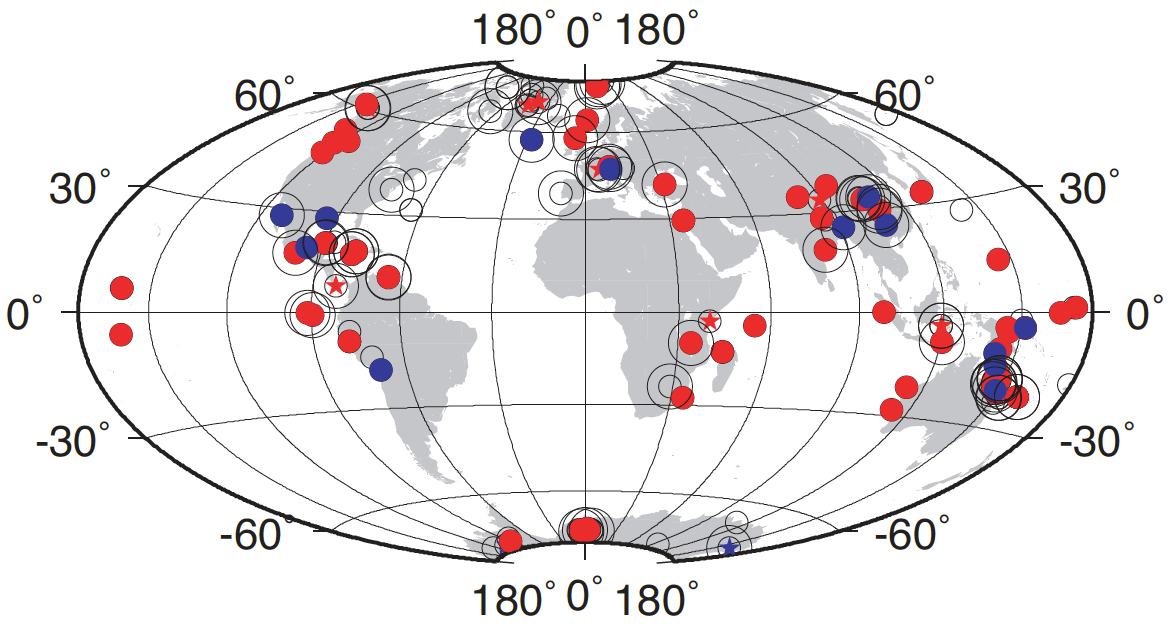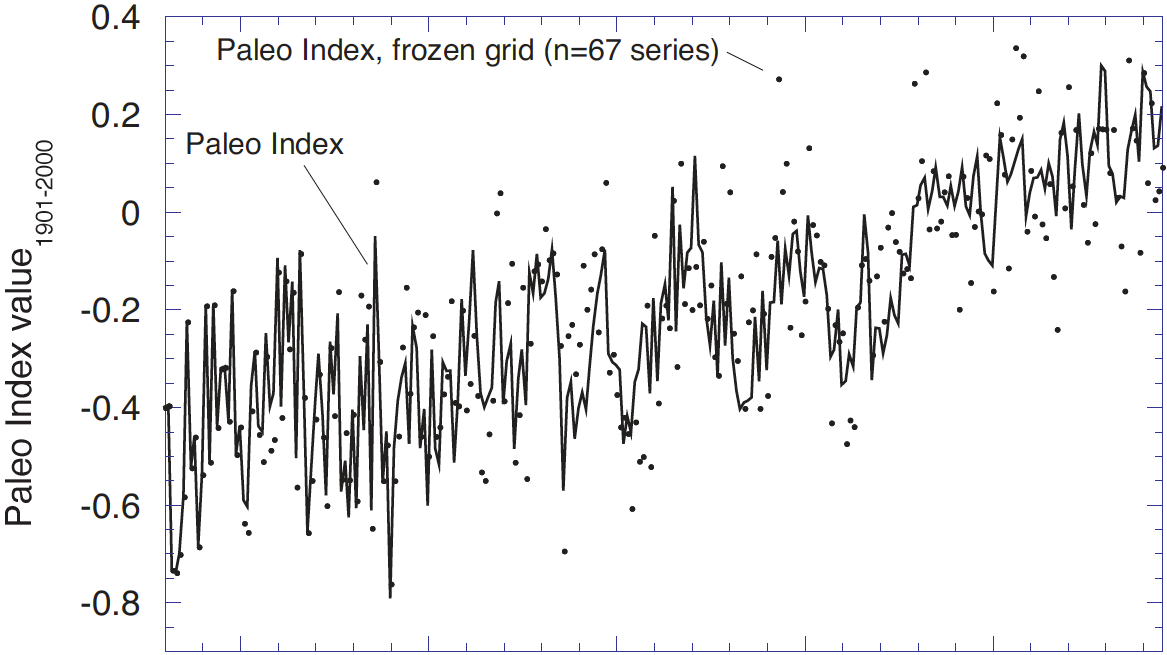Nature Confirms Global Warming and Temperature Record Accuracy
Posted on 12 January 2013 by dana1981
Climate contrarians frequently dispute the accuracy of the instrumental surface temperature record, as is evident by the fact that this argument comes in at #7 on our list of most used climate myths. In fact, we recently pointed out the fundamental errors in a draft paper which disputed the temperature record's accuracy.
A new paper published in Geophysical Research Letters by Anderson et al. (2012) tests this myth by creating a new global surface temperature record reconstruction using records from 173 natural temperature-sensitive changes (in corals, ice cores, speleothems, lake and ocean sediments, and historical documents), with 67 of these records extending as far back as 1730.
The paper compares their natural temperature reconstruction (Paleo; solid line in Figure 1) to the instrumental surface temperature record (MLOST; dashed line in Figure 1) and finds a strong correlation (of 0.76) between the two.
Figure 1: Paleo Index (solid) and the merged land-ocean surface temperature anomalies (MLOST, dashed) relative to 1901-2000. The range of the paleo trends index values is coincidentally nearly the same as the GST although the quantities are different (index values versus temperature anomalies °C).
Overall, Anderson et al. concludes,
"From 1880 to 1995, the index trends significantly upward, similar to the GST [global surface temperature record]. Smaller-scale aspects of the GST including two warming trends and a warm interval during the 1940s are also observed in the [paleo reconstruction]....The upward trend appears to begin in the early 19th century but the year-to-year variability is large and the 1730–1929 trend is not significant."
Data and Methods
Anderson et al. selected natural records with some type of physical or biological link to global surface temperatures (proxies). The records they chose contained at least ten samples between 1880 and 1995 in order to achieve decadal resolution. Of the records used in the paper, 40 have decadal resolution, and the remaining 133 have even better annual resolution. Tree rings (which are often used as temperature proxies) were excluded because use of tree ring proxies can result in loss of short-term variations in the data, due to the de-trending process employed in using them as a temperature proxy.
Based on the availability of the records, the paper reconstructs proxy temperatures between 1730 and 1995. Although there are other natural environmental influences on each individual natural proxy besides global surface temperture, the assumption is that by averaging so many records together, these other influences will be minimized, leaving a reasonable approximation of global surface temperature changes.
The locations of the proxy datasets are shown in Figure 2. Red circles are measurements with a significant warming trend from 1880 to 1995, red stars are less significant trends, open circles show no trend, blue circles are locations with significant cooling trends, blue stars with less significant cooling trends, and double circles show the records which extend as far back as 1730.
Figure 2: Sites with significant warming trend 1880-1995 (red, p<0.05), less significant trend (red star, 0.05<p<0.20) trend, and no significant trend (open circle, p>0.20); also sites with a significant cooling trend (blue, p<0.05) or less significant cooling trend (blue star, 0.05<p<0.20). Double-circles show 67 sites extending to 1730.
Results
"Thus, using only temperature-sensitive paleo proxy records un-calibrated to instrumental data, it is possible to conclude that the warming trend in the [instrumental temperature record] is supported by independent evidence."
As shown in Figure 2, records all around the planet show significant warming trends. As the authors note,
"The significant positive (warming) trend is widespread, found in Arctic, sub-polar, temperate, and tropical sites....Therefore, the distribution of the paleo sites supports the global extent of warming observed in the instrumental record."
As shown in Figure 1, Anderson et al. creates its own "Paleo Index Value" which it does not convert to temperature units, but rather examines the correlation with the surface temperature record trend (from NOAA NCDC). The paper finds a strong correlation of 0.76 between the two records and concludes,
"Thus, using only temperature-sensitive paleo proxy records un-calibrated to instrumental data, it is possible to conclude that the warming trend in the GST is supported by independent evidence."
The warming trend in the Anderson reconstruction is larger from 1920 to 1935 (0.260 ± 0.056 units per decade) than from 1980 to 1995 (0.071 ± 0.015 units per decade), but the same is true in the instrumental record (0.115 ± 0.132°C vs. 0.087 ± 0.138°C per decade, respectively). However, when we include instrumental data post-1995, the recent warming trend becomes larger than the early 20th century warming trend in the instrumental record.
Examining the temperature reconstructions which extend furthest back in time, the paper also confirms that the planet is now hotter than it has been in at least the past 280 years (Figure 3). They also find a very small, insignificant warming trend from 1730 to 1928 (0.001 ± 0.004 units per decade), with the slight warming beginning around the year 1800.
![]()
Figure 3: Paleo temperature reconstruction index extending back to 1730 (solid line), derived by averaging only the sites that begin prior to 1730 (dots).
Summary
Overall this new nature-based temperature reconstruction confirms the main aspects of the global surface temperature record. There was a warming event in the early 20th century, after which surface temperatures were relatively flat until the late 20th century, at which point there was another warming event. The 1920–1935 warming was larger than the 1980–1995 warming, but according to the instrumental temperature record, was smaller than the 1975–Present warming.
The strong correlation between the two datasets confirms the general accuracy of the instrumental temperature record.
This natural temperature reconstruction also shows there has been significant warming all around the planet over the past century, and that current global temperatures are higher than they have been in at least the past 280 years.
Note: this post has been used to update the rebuttals to the myth that the instrumental temperature record is unreliable.































 Arguments
Arguments


























 0
0  0
0






Comments